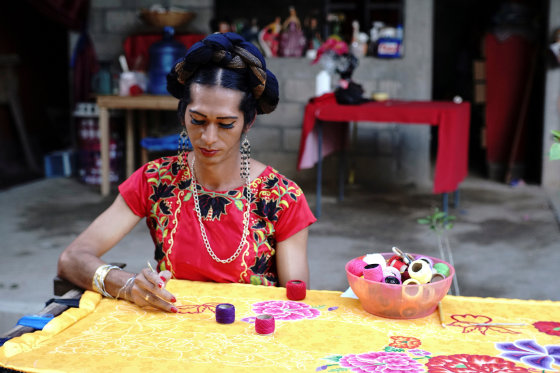JUCHITAN, Mexico - A culture of indigenous transgender women that has been part of southern Mexico's heritage for centuries is primed for global fashion cachet thanks to one of the world's top style magazines.
For the first time in Vogue magazine's more than 120 years of publishing, an indigenous "muxe" will appear next month on the cover of the glossy's Mexican and British editions.
Muxes, a term probably derived from the Spanish word mujer meaning woman, are indigenous transgender women who easily mix gay male and feminine identities.
The cover photo features Estrella Vazquez, a tall, lanky 37-year-old indigenous Zapotec muxe wearing a traditional huipil garment with colorful flowers and holding a pink fan in one hand. The weaver and designer sees the cover as a sign of receding bigotry in Mexico toward muxes.
Historically the country's ingrained Roman Catholic heritage has reinforced anti-gay and anti-transgender prejudice. "I think it's a huge step," Vazquez told Reuters in Juchitan city in southern Oaxaca state, home to perhaps the largest muxe (pronounced MOO-she) community. "There's still discrimination, but it's not as much now and you don't see it like you once did," she said.
While muxes are not well known outside Mexico, within the country it is not uncommon to see muxes at gay pride parades or other cultural events. No statistics are collected, but the muxe community is thought to number in the hundreds or thousands.
In August, Vazquez, who had never heard of Vogue, was invited along with a dozen other muxes by the magazine to participate in a photo shoot. Vogue wanted to highlight Oaxaca's indigenous cultures, she said.
"Everyone is seeing this cover, everyone is congratulating me. I don't know; it's just hard to make sense of the emotions I'm feeling. It almost makes me want to cry," she said.
Many muxes historically have been caregivers to aging parents, a role that has given them prestige in families which typically are shaped by Mexico's macho, male-dominated culture.
Muxes also played a leading role in the aftermath of a massive 8.1 magnitude earthquake that struck Juchitan in 2017, as many worked to dig out trapped family and friends from the rubble, often using their bare hands.
Vogue, owned by New York-based Conde Nast, publishes more than 20 editions of the magazine around the world with circulation of 24.4 million.



